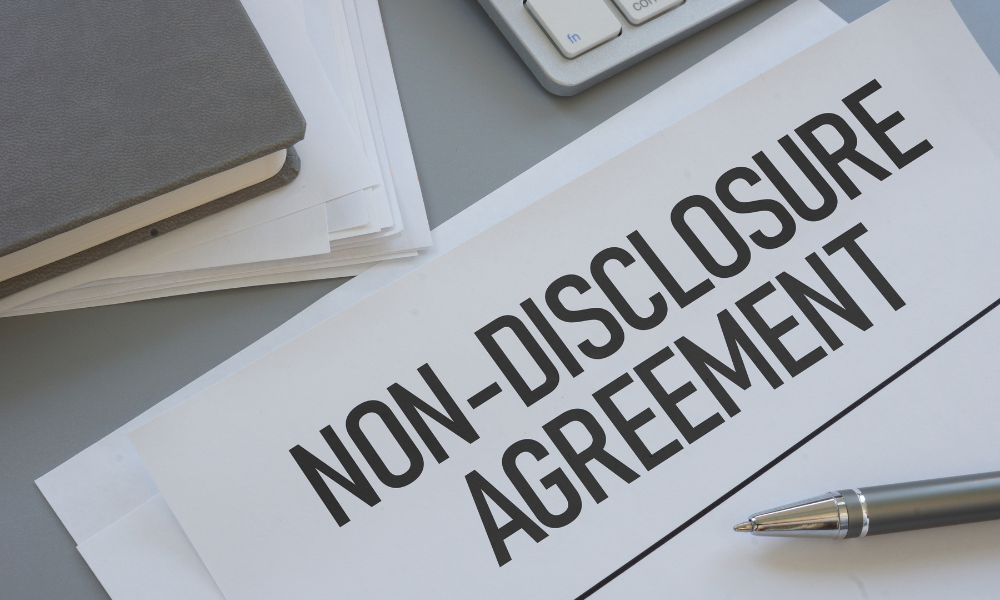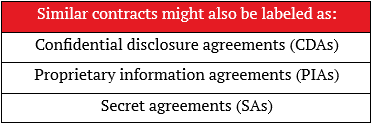
A non-disclosure agreement is a contract that keeps information private. This guide helps HR use NDAs responsibly by covering types, key parts, and ethical use

In every organization, there comes a time when sensitive information must be shared. Whether it's during hiring, product development, or vendor relationships, non-disclosure agreements (NDAs) give companies a layer of legal protection and peace of mind. But what exactly do they cover, and how should HR teams use them?
This guide breaks down how NDAs are used in the workplace and what makes them effective. It will include how HR professionals can manage them responsibly—from onboarding to enforcement, as well as their key elements.
Together, we’ll also explore how non-disclosure agreements differ from similar contracts, explain when they do more harm than good, and encourage their ethical use in HR.
An NDA is used a lot in businesses to safeguard the company and its workforce. It is a legal contract that prevents the sharing of confidential information. It's often signed between:
The person or company sharing the information is called the disclosing party, while the one receiving it is the receiving party. Once signed, the receiving party agrees not to disclose any protected data.
This means that all parties who signed have understood and agreed that sensitive information they receive will not be released to the public and will only be shared between the parties involved.
An NDA works by setting the rules for how sensitive information is shared—and more importantly, how it’s kept private.
The contract helps create a clear and structured path for handling confidential data. It often comes into play when an employee joins a company, a contractor starts a project, or two businesses begin talks.
A non-disclosure agreement builds trust by giving both sides a safe space to share information without worrying it will be leaked or sold.
In simple terms, an NDA says: “We’re going to share something private—and you agree not to spread it.”
A good NDA will spell out exactly what information needs to stay private. This could include:
Without this kind of contract, there’s no legal safety net if the information is exposed.
While the terms non-disclosure agreement and confidentiality agreement are often used interchangeably, they aren’t always the same.
Some sources suggest that NDAs are more commonly used in legal or transactional settings, while confidentiality agreements show up more often in internal employment or collaborative roles.
What matters most is the purpose and scope of the contract. Both types of agreements aim to keep private information from being disclosed—but they may carry different legal weight or expectations depending on the situation and how they're written.
A practical example is shown below:
confidentiality agreement: a designer and a manager work together to develop a new product. They share ideas and files, and both agree to keep the work private. A confidentiality agreement suits this situation because the flow of information goes both ways.
non-disclosure agreement: a marketing agency hires a new employee who will have access to client lists and future campaign strategies. The employee signs an NDA to ensure that data stays within the company.
This difference matters. That’s why HR leaders and employers should treat these as distinct agreements. Using them interchangeably can cause misunderstandings, or worse, leave sensitive information legally unprotected.
Make sure to check this article out to learn more about the difference between NDAs and confidentiality agreements.

An NDA can be created for different reasons, but its purpose remains the same. For employers to understand what kind of agreement they need, it is important to discuss the three types of non-disclosure agreements:
Also called a one-way NDA, this involves one party sharing confidential information with the other parties, who agree to keep it confidential.
It is the most common type of agreement businesses use. There are four basic types of unilateral non-disclosure agreements:
employer-employee agreements: ensures employees do not leak or use specific company information during or after the time period of their employment. It is usually signed by employees once they are hired
seller-buyer agreements: restricts buyers from sharing confidential information they received during the purchase of the seller’s goods or services. It helps preserve the seller’s position during and after the business relationship
company-contractor agreements: contractors often need access to internal systems or records. This agreement limits what they can do with that access and holds them accountable for anything they see or handle after signing an NDA
inventor-evaluator agreements: shields inventors from their works being plagiarized or stolen by an evaluator. The focus of the agreement is to protect the intellectual property of the inventor, especially If the invention remains unpatented
This is also known as mutual or two-way NDAs. This contract expects both or all parties to share and disclose sensitive information to each other.
This is different from a regular NDA, which is typically a unilateral agreement where only one party shares information.
Common situations that use the bilateral non-disclosure agreement are when companies start new joint ventures and mergers and acquisitions. It also includes any other actions that would see both parties having to share proprietary information.
To learn more about mutual NDAs, read this article on how it can be a valuable tool for professionals.
Also known as multiparty, this is an agreement that is between three or more parties. In this set up, at least one party will get to disclose information while the others are expected to keep the newly acquired information private.
This type of confidentiality agreement is not as common as the first two. But it is convenient because there's no need for multiple separate contracts. It also allows all parties to review, implement, and disclose information under one shared agreement.

Once the different types of NDAs are understood, a well-drafted agreement should include these key elements:
Let’s take a closer look at each:
This is one of the most important pieces to lock in early. The parties to the agreement must be clearly named.
Whether it’s an employee, investor, contractor, or third-party group, their roles and relationship to the agreement must be identified.
HR leaders should take the time to see if there will be other external groups of people who would be affected by the agreement and whether they should be included in the contract.
Once the parties are identified, their role in the agreement needs to be established. As such, these questions must be answered:
Knowing the roles of each party helps map out the sharing of confidential information. It can also help build their roles of what is required of them in the agreement.
This section defines what qualifies as protected information. HR leaders should clearly identify:
It’s critical to make this section fair and balanced. The agreement shouldn’t favor one party’s interests more than the other’s.
Just like any contract, a non-disclosure agreement includes exceptions. These are situations where a party is not obligated to keep information private.
Examples include:
Vague wording or unclear clauses in the NDA can lead to confidentiality breaches or legal challenges. Using clear, specific language helps all signatories understand their responsibilities and comply with the NDA.
Read this Canadian case to learn how vague confidentiality clauses can render termination provisions unenforceable.
The length of an NDA can affect both how burdensome it is for the receiving party and how enforceable it is in court. So, how long do non-disclosure agreements last?
Well, there’s no one-size-fits-all answer. The time period for confidentiality depends on the nature of the project, the sensitivity of the data, and the business relationship involved.
Here’s how to frame it:
While some NDAs are written to last indefinitely, most include a clear expiration to avoid confusion.
A definite and reasonable term makes sure that both sides stay accountable, even after the information has been used or the project has ended. This unloads the pressure of keeping the information confidential once the data has been deemed irrelevant.
Feel free to download this NDA template we prepared. You can expand on this format by adding specific terms or conditions to make the agreement more detailed, transparent, and fair to both parties.
Content and intent may vary depending on applicable state laws and industry practices. It’s best to consult an employment and labor law expert when finalizing the NDA.
Yes, non-disclosure agreements are legally enforceable as long as they meet certain requirements. A court will uphold an NDA that is clearly written, fairly structured, and properly signed by all parties to the agreement.
To be enforceable, an NDA must:
You can refer to this article for a deeper understanding of how NDAs are upheld in court.
Not necessarily. Even if a non-disclosure agreement is signed, it can still be ruled unenforceable by a court if it includes unclear or overreaching language.
For example, if the agreement uses vague terms, lacks a defined time period, or tries to secure information that isn’t actually confidential, the whole contract may fall apart.
Some NDAs even include clauses that attempt to stop someone from reporting illegal activity—and that’s a legal red flag.
As an HR professional, it’s essential to review every NDA for fairness and compliance. That means making sure the terms are clear, the parties to the agreement are correctly identified, and that the contract doesn’t cross legal or ethical lines.
If you're unsure, it’s always smart to run it by legal counsel before asking anyone to sign.
A non-disclosure agreement is considered a legally binding contract. In effect, when an NDA has been breached, whether the violation was intentional or not, there can be serious consequences. This could lead to legal action against the violating party.
Penalties can vary depending on the situation, but they may include:
It all depends on the severity of the breach, what penalties are outlined in the agreement, and whether it violated any state or federal laws.
Both the disclosing and receiving party should understand the recourse available if the agreement is violated.
According to Cornell Law, the harmed party can seek monetary compensation and even court-ordered action to prevent further harm. In some cases, the NDA itself will include a clause that sets specific remedies or penalties in the event of a breach.
NDAs offer a strong layer of protection, especially when businesses need to safeguard sensitive data like financial records, intellectual property, or client details.
When used correctly, a non-disclosure agreement can encourage good faith, set clear boundaries, and protect both parties in a business relationship. It also aims to secure the parties involved from any blackmail or misuse of information.
For more best practice ideas on using NDAs, reach out to one of the top HR leaders in the world. Many of them share strategies and insights that could inspire how your team approaches NDA use and broader people management practices.
Not always. There are real risks when non-disclosure agreements are used to suppress transparency or silence wrongdoing. For example, NDAs cannot and should not be used to:
In some cases, using an NDA this way can violate employment laws—or worse, cross ethical and constitutional lines. Here’s an example: former Nickelodeon stars speaking out about how NDAs were allegedly used to silence reports of misconduct and abuse.
There’s growing scrutiny around the overuse of non-disclosure agreements, especially in high-profile misconduct cases. Critics point to the way these contracts have been used to silence whistleblowers, suppress employee concerns, and protect power imbalances.
Real-world examples include:
But these did help spark legislative change. Such incidents led to the passing of the MeToo law, which now limits the use of forced arbitration in workplace harassment cases.
Still, not all concerns have been addressed. In some instances, companies have asked employees to sign NDAs after reporting serious allegations—an action that can be seen as coercive or retaliatory.
And on the flip side, employees may also misuse NDAs. For example, someone could sign a non-disclosure agreement with a competing firm and leak insider knowledge from a previous employer. This type of breach can lead to costly legal battles and reputational damage on both sides.
In the same way that non-disclosure agreements have drawn criticism, there’s also increasing pressure to scale back overly broad non-compete agreements.
Courts and lawmakers are recognizing that these restrictive contracts—like NDAs—can be misused to limit worker mobility, stifle innovation, or discourage transparency.
Some states have already moved to limit non-competes unless they’re narrowly tailored to safeguard legitimate business interests.
Before drafting or signing an NDA, HR leaders should ask:
To avoid legal and ethical missteps, it helps to start with a reliable NDA template, which can also be vetted by legal counsel. Take a look at this article on what makes a good mutual NDA template.
Better yet, consult a compliance expert or use contract lifecycle software to standardize confidentiality disclosure agreements across your team.
While it may seem simple to draft a non-disclosure agreement, HR leaders know every word matters. A vague or one-sided NDA can create legal trouble, clash with other contracts, or expose sensitive data. That’s why it pays to slow down and get it right.
This guide shows how quickly an NDA can become a legal or ethical risk if reused without care. Each one should be reviewed in context—who it affects, what it protects, and how it supports transparency.
These types of restrictive covenants already carry legal weight and growing controversy. So, HR professionals need to understand how they continue to reshape workplace policies and protections.
When done right, NDAs should build trust, not just shield information.
Have you encountered issues or problems with NDAs for your employees? Drop a comment below and share your thoughts